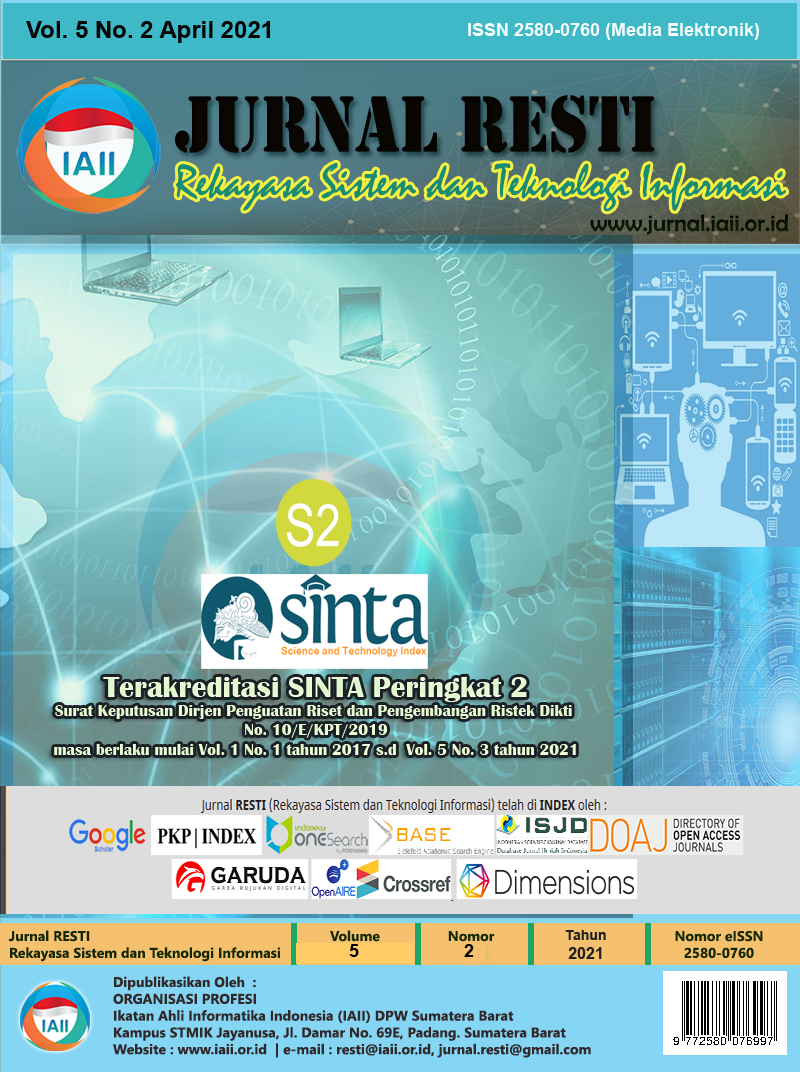Metode PCQ dan Queue Tree untuk Implementasi Manajemen Bandwidth Berbasis Mikrotik
Abstract
Bandwidth problems are the most frequently encountered problems in sharing information traffic or internet access on computer networks. The factor that causes slow internet access is the large number of devices connected to the internet that are not matched by the availability of sufficient bandwidth and the lack of available bandwidth. This can be accommodated with bandwidth management methods. Bandwidth management in Mikotik uses several bandwidth sharing methods such as PCQ (Per Connection Queue), Queue Tree, and HTB (Hierchichal Token Bucket). This research uses 2 (two) bandwidth management methods, namely PCQ and Queue Tree because these methods can divide bandwidth automatically according to the number of active users and are more effective in sharing bandwidth based on Mikrotik. PCQ is a method aimed at optimizing QoS for large-scale internet networks where all queues are the same for all sub-streams, while Queue Tree is a method designed to carry out more complex queuing tasks for network traffic. The purpose of this research is to optimize the limited internet bandwidth so that it can be accessed by all users in the Local Area Network and automate the queue of devices connected to the network according to user needs so as to produce a more stable computer network performance using the network development method, namely NDLC. The results of the tests were carried out 10 times using a bandwidth of 10 Mbps which resulted in an average jitter of 1.64 ms, ping 36.8 ms, 2 Mbps throughput, and 0.1% packet loss so that the QoS of internet access was categorized as satisfactory. It is hoped that from this research the company will be able to save on internet access expenses by maximizing a small bandwidth without having to increase the existing bandwidth.
Downloads
References
T. O. D. Putra, W. Widiarto, and Wiharto, “Implementasi Algoritma Load Balancing PLBA Komputasi Grid pada Lab Environment Menggunakan PVM3,” J. RESTI (Rekayasa Sist. dan Teknol. Informasi), vol. 4, no. 6, pp. 1190–1197, 2020, doi: 10.29207/resti.v4i6.2606.
Sukri and Jumiati, “Analisis Bandwidth Menggunakan Metode Antrian Per Connection Queue,” RABIT J. Teknol. dan Sist. Inf. Univrab, vol. 2, no. 2, pp. 136–151, 2017.
B. Prasetyo, A. Puspitasari, and R. Nasution, “Implementasi Manajemen Bandwidth Dan Filtering Web Access Control Menggunakan Metode Address List,” JIKA (Jurnal Inform., vol. 3, no. 2, pp. 73–82, 2019, doi: 10.31000/jika.v3i2.2192.
F. R. Doni, “Implementasi Manajemen Bandwidth pada Jaringan Komputer dengan Router Mikrotik,” Evolusi J. Sains dan Manaj., vol. 7, no. 2, pp. 52–57, 2019.
A. I. Wijaya and L. B. Handoko, “Manajemen Bandwidth Dengan Metode Htb ( Hierarchical Token Bucket ) pada Sekolah Menengah Pertama Negeri 5 Semarang,” J. Tek. Inform. Udinus, vol. 1, no. 1, pp. 1–3, 2015.
G. F. E. Ardiansa, R. P. Primananda, and M. H. Hanafi, “Manajemen Bandwidth dan Manajemen Pengguna pada Jaringan Wireless Mesh Network dengan Mikrotik,” J. Pengemb. Teknol. Inf. dan Ilmu Komput., vol. 1, no. 11, pp. 1226–1235, 2017, doi: 10.32736/sisfokom.v4i1.203.
Firmansyah, A. Fadlil, and R. Umar, “Identifikasi Bukti Forensik Jaringan Virtual Router Menggunakan Metode NIST,” J. RESTI (Rekayasa Sist. dan Teknol. Informasi), vol. 5, no. 1, pp. 91–98, 2021.
Lisnawita, “Manajemen Bandwidth Menggunakan Metode Hierarchical Token Bucket (HTB),” J. Teknol. Komun. Digit. Zo., vol. 7, no. 1, pp. 18–25, 2016.
A. Syukur, “Analisis Management Bandwidth Menggunakan Metode Per Connection Queue (PCQ) dengan Authentikasi RADIUS,” It J. Res. Dev., vol. 2, no. 2, pp. 78–89, 2018, doi: 10.25299/itjrd.2018.vol2(2).1260.
Hardiman, L. F. Aksara, and Subardin, “Analisis Perbandingan QOS (Quality of Service) pada Manajemen Bandwidth dengan Metode PCQ (Per Connection Queue) dan HTB (Hierarchical Token Bucket),” semanTIK, vol. 4, no. 1, pp. 121–128, 2018.
P. Ferdiansyah, R. Indrayani, and S. Subektiningsih, “Analisis Manajemen Bandwidth Menggunakan Hierarchical Token Bucket Pada Router dengan Standar Deviasi,” J. Nas. Teknol. dan Sist. Inf., vol. 6, no. 1, pp. 38–45, 2020, doi: 10.25077/teknosi.v6i1.2020.38-45.
M. Nugraha, “Implementasi Manajemen Bandwidth Dengan Disiplin Antrian Hierarchical Token Bucket (HTB) pada Sistem Operasi Linux,” Telematika, vol. 13, no. 2, pp. 99–106, 2017, doi: 10.31315/telematika.v13i2.1726.
Martini, E. Mufida, and D. A. Krisnadi, “Implementasi Manajemen Bandwidth menggunakan Metode Queue Tree (Studi Kasus pada Universitas Pancasila),” J. Teknol. Inform. dan Komput., vol. 5 No. 1, no. 1, pp. 19–23, 2019.
R. Oktaviani and D. Novianto, “Manajemen User Dan Bandwidth Pada Hotspot Di Kantor BUMD Provinsi Bangka Belitung Menggunakan Router Mikrotik,” J. SISFOKOM, vol. 04, no. 01, pp. 47–55, 2015.
J. E. Goldman and P. T. Rawles, Applied Data Communication: Business Oriented Approach. Fourth Edition. New York: John Wiley & Sons Inc, 2014.
S. Surono, F. W. Christanto, and C. Maulana, “Uji Komparasi Quality of Service Antara Metode Routing dan VLAN pada Distribusi Paket Data Jaringan Internet,” JPRT (Pengembangan Rekayasa dan Teknol., vol. 16, no. 2, pp. 183–190, 202
Copyright (c) 2021 Jurnal RESTI (Rekayasa Sistem dan Teknologi Informasi)

This work is licensed under a Creative Commons Attribution 4.0 International License.
Copyright in each article belongs to the author
- The author acknowledges that the RESTI Journal (System Engineering and Information Technology) is the first publisher to publish with a license Creative Commons Attribution 4.0 International License.
- Authors can enter writing separately, arrange the non-exclusive distribution of manuscripts that have been published in this journal into other versions (eg sent to the author's institutional repository, publication in a book, etc.), by acknowledging that the manuscript has been published for the first time in the RESTI (Rekayasa Sistem dan Teknologi Informasi) journal ;








